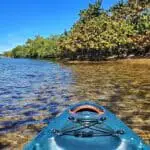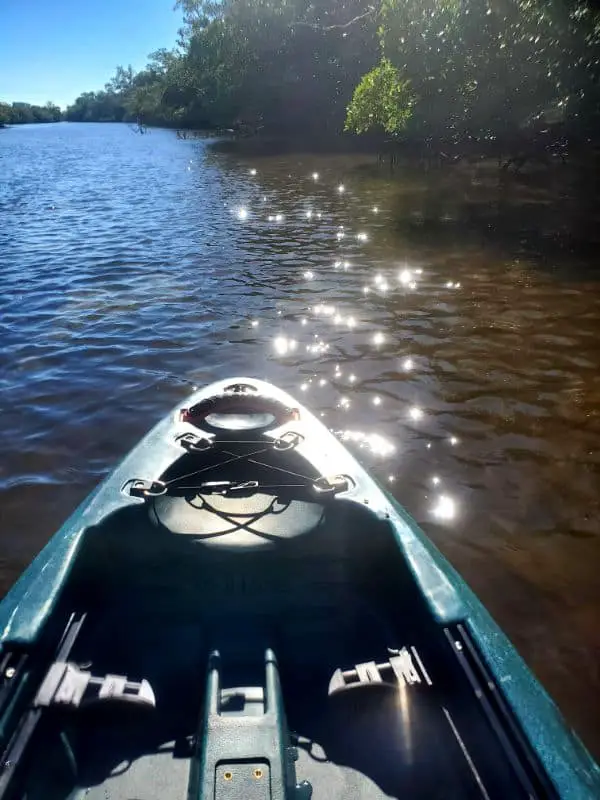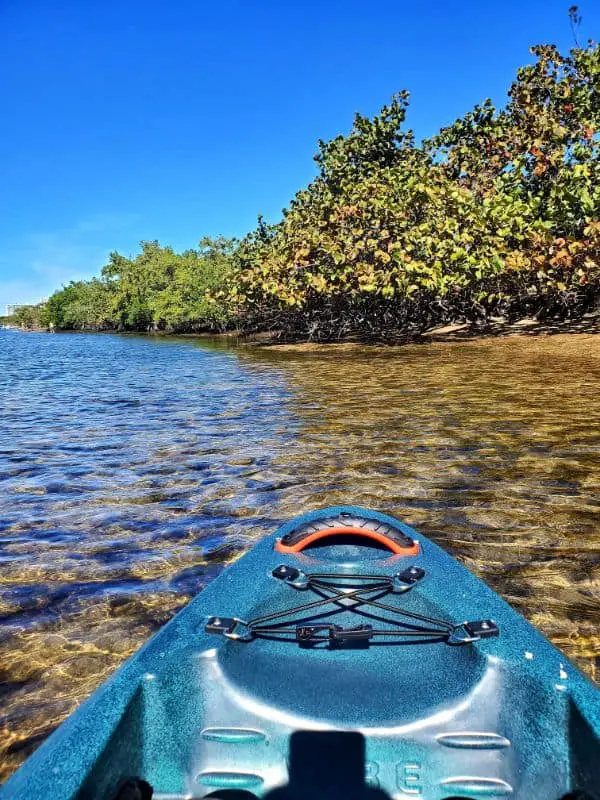Affordable Gear List for Recreational Kayaking – Waterproof Essentials

Meet the Guide!
Dog lovin’, kayak lovin’ extraordinaire!

Gear Guide Introduction
Who This Guide Is For:
This Gear List is for beginner and intermediate kayakers interested in recreational kayaking on lakes and rivers and beginner whitewater kayakers up to Class 3.
This Gear list applies to both inflatable, sit-on-top fishing, sit-in recreational, and whitewater kayaks. You can even use most of the information for paddle boarding!
With the right kayak, you can explore any of the following:
- Class 1 and Class 2 Rivers (sometimes Class 3-4!)
- Lakes, lagoons, bays, marshes, ponds
- Easy shoreside sea kayaking
- You can enjoy overnight adventure trips.
- And with a premium inflatable whitewater or expedition kayak, you can even tackle Class 3 whitewater!
Best you need to keep your stuff (and your craft) dry. That’s where this Mini Gear Guide comes in handy. Here are my recommendations for waterproof gear essentials for kayaking.
Visual Inspiration

Activity Demonstration
Safety & Risk
What Are the Dangers of This Activity?
You can drown. You can break a leg. You can smash your skull. Water is dangerous, people!
The two biggest hazards on rivers are holes and strainers.
- Holes are recirculating water currents, usually formed when water drops over an obstruction, like a submerged rock. Powerful recirculating currents also exist at the edges of an eddy or at the base of a low head dam. Many a kayaker has died in a hole, sucked down to the cloudy depths below.
- Strainers are formed by obstructions in the waterway, such as a cleft between two rocks or a submerged tree. Water can pass through, but a human cannot. Many a kayaker has died by getting a foot trapped between two rocks, with the strong river current forcing their bodies sideways and underwater. You can die in 2-3 feet of water if the current is strong enough.
A full description of safety while inflatable kayaking is beyond the scope of this article. Dangers include everything from drowning to hypothermia to bacterial infection.
Here are several of my personal recommendations:
- Wear a helmet! ‘Nuff said.
- Wear a PFD life jacket. Also ‘nuff said.
- Tell someone where you’re going. And preferably, don’t go alone!
- If the water’s cold, wear a wetsuit. The shock of cold water alone can stun your muscles and render them partially immobile, leading to drowning.
- When in doubt, scout. Never run a rapid you aren’t familiar with.
- If you fall out of your craft, float with your feet pointing downstream, your head out of the water, and your arms guiding you.
- Bring a whistle and know the accepted signals for calling for help. Better yet, bring a GPS tracker.
- Double-check your watercraft. Check for holes and other damages before and after every voyage.
- Hypothermia can set in the ’50s or ’60s! Water conducts heat away 25x faster than air!
- Wear your helmet and PFD!
- Don't go alone.
- Don't kayak in water above your skill level.
What Is Recreational Kayaking?
Lorem ipsum dolor sit amet, consectetur adipiscing elit. Ut elit tellus, luctus nec ullamcorper mattis, pulvinar dapibus leo.
Waterproof Essentials - Gear List for Recreational Kayaks
Gear List for Recreational Kayaking
This is a Mini Gear Guide. We’re not talking about ALL the gear you need to go kayaking, just the waterproof essentials.
The right gear can make all the difference between a safe and comfortable kayak trip or one filled with lots of cursing, soggy shoes, and your smartphone falling into a watery grave!
Of course, some of the gear needed will depend on the type of kayaking you will doing and for how long. If you are planning an icy kayak expedition in the Alaskan backcountry or a weeklong paddle-n-camp through the Rio Grande this article is not for you. If you are somewhat of a newbie kayaker looking for the basics for a good day on the water you’re in the right place.
Let’s take a look at some waterproof gear essentials for kayaking!
1. Dry Bag
There are seemingly a million options out there for dry bags. From small pouches to large backpacks it’s easier than ever to find one that fits your needs. Regardless of what type you pick, if you are unable to secure it to your kayak somehow make sure it floats! Unless you are a great diver, having a drybag that doesn’t float will become an exercise in futility if you capsize or it gets dropped.
Most dry bags are made of nylon, PVC, or a combination of both. To get the best protection, a dry bag with at least two layers is ideal. That doesn’t necessarily mean the dry bag will be heavy or bulky though, there are good quality lightweight dry bags with a waterproof coating. Single-layered thin dry bags are typically good for backpacking if you get caught in the rain but can’t always be trusted with a submersion.
The sealing mechanism on a dry bag is also of utmost importance. Rolltop designs that typically have a buckle or clip on top tend to be the most reliable. They provide two or more levels of protection with each roll. Zip-top dry bags can leave micro openings where water could get in if not sealed perfectly. Any dry bag that has two or more ways to seal it is ideal!
While there’s no shortage of affordable options on online marketplaces, when it comes to dry bags–you get what you pay for! Many of the cheaper dry bag options are not actually waterproof, even if they advertise as such. Whichever dry bag you choose, it’s a good idea to test it out by submerging it in a sink or bathtub at home before you hit the open water.
Here’s a look at some top-rated affordable dry bag options:
Seal Line Discovery™ Deck Dry Bag
The Seal Line brand has roots in the maritime industry and is known for producing quality waterproofing gear. Their Discovery™ Deck Dry Bag is no exception. It’s one of the most highly rated dry bags online and also very affordable. Prices currently range from $45 – $65 depending on size. It comes in a variety of colors and sizes and has a unique compression valve feature not often found on other dry bags.
Sea to Summit Big River Dry Bag
Sea to Summit is well known for its quality adventure gear and lifetime guarantee. The Big River Dry Bag is a top-rated choice amongst paddlers for its well-constructed and “abrasion-resistant” design. It comes in multiple sizes and color choices and currently retails for $28 – $65.
Gecko Waterproof Tarpaulin Dry Bag Waist Pouch
For a smaller, wearable option–the Gecko Tarpaulin Dry Bag will hold a phone, wallet, keys, and maybe a few snacks comfortably around your waist. Its PVC rolltop design will keep your valuables dry throughout paddle splashes or accidental submersions. It’s lightweight, has adjustable straps, and comes in multiple designs. This bag is currently priced from $24 – $32.
Dry Bag Checklist
Make sure your dry bag is:
- Attachable or floatable
- Big enough–overstuffing can lead to breaks in the waterproof seal!
- Tested–place a paper towel inside and submerge in a sink or bathtub
2. Waterproof Phone Case
While you can store your phone in your dry bag if you’ll be taking it out often to look at a map or take photos it’s better off in its own little safe space. A waterproof phone case will save you the hassle of having to stop and dig through your dry bag while being so very careful not to drop anything.
Let’s not forget about rogue waves, boat wakes, or unexpected dolphin splashes. I once almost sacrificed my phone to Poseidon to take pictures of some dolphins that ended up swimming right up to me and creating massive waves. My phone got soaked but lived to tell the tale! Now I always use a waterproof phone case.
Just like dry bags, there are tons of options out there for phone cases. Personally, when it comes to protecting expensive electronics, I go with the name brand. Buying a cheaper waterproof phone case will cost you much more in the long run should it fail. I’ve tried a lot of different phone cases over the years and my favorite is the Cali Case. It’s made for filming underwater so it’s fully submersible (up to 100 feet) but it’s lightweight and floats. I’ve put the Cali Case to the test on many a kayak trip as well as an hour-long dunk in a cenote. It’s still holding strong!
Reasons I recommended the Cali Case:
- Fits many different types/sizes of phones
- Has a double layer of PVC protection
- The touchscreen is still usable
- Takes great photos/videos in or out of the water
- It’s usually priced around $30 or less
3. Waterproof First Aid Kit
It’s always a good idea to have a small first aid kit on you when you are out on the water. Especially if you’ll be paddling far or out for the whole day. An unexpected blister from your oar after hours of paddling, a headache, or insect sting can be quickly remedied with your first aid kit. It’s just one of those things you’d rather have and not need than need and not have!
You can buy a curated Paddler’s First Aid Kit or Marine Medical Kit or make your own in a waterproof pouch or case. Be sure to check your kit before you head out for any items that may be expired or need refilling.
Items to include in your kayak first aid kit:
- Bandages
- Sterile Gloves
- Antiseptic Pads
- Antibiotic Ointment
- Pain Relievers such as Advil and Tylenol
- Stomach Medications such as Antacids and Pepto Bismol
- Antihistamines such as Benadryl
- Sting Relief Pads
- Aspirin
- Aloe or Burn Gel
4. Waterproof Cooler
If you’re going to be kayaking for more than a few hours you’ll probably want to bring along some food and extra drinks. To keep your sandwiches from getting soggy and your drinks cold, a waterproof cooler can be a kayaker’s best friend!
Look for a cooler that is space-saving, has some level of water resistance, and is attachable to your kayak in some way.
A slim, behind-the-seat cooler is a great option for saving space. The Skywin Kayak Cooler is one of the most highly rated and affordable options currently retailing from $35 – $50. It attaches to most kayak seats and is fully waterproof.
For soft-sided coolers, the Icemule “On the Water” collection has several options of top-rated soft coolers made for watersports. These coolers are rated for 24 hours and come in a variety of sizes and colors currently ranging from $60 – $120.
5. Water Shoes
Kayak launch sites are usually going to be wet and slippery, sometimes even rocky. A good pair of grippy, water shoes will always be a worthwhile piece of gear to have when kayaking.
There are endless options of water shoes to choose from and as long as they are comfortable and do the job get whichever suits you best!
If you are looking or a bit more support or planning to kayak to a hiking destination and don’t want to have to carry extra shoes there are hiking/water shoe hybrids out there from almost all major outdoor brands. Keen and Salomon in particular are known for their extensive “amphibious” shoe lines.
6. Spray Skirt & Dry Top
If you have a sit-in kayak, a spray skirt and dry top are essential in colder or choppier waters. Designed to provide a waterproof seal around the kayaker, a spray skirt will help protect from splashes and rain.
In addition to the spray skirt, a dry top can also be utilized for fuller protection. These are similar to drysuit tops but typically offer more cold weather protection and can attach to the dry skirt.
Both spray skirts and dry tops are usually made from nylon, neoprene, or a combination of the two. Some are also made with high-tech GORE-TEX® material which is waterproof and windproof.
There are a lot of factors to consider when choosing which spray skirt, dry top, or combo to buy. Spray skirts can range from $50 – $200 and have a variety of different features. Be sure to measure the cockpit of your kayak to ensure proper fit. Many kayakers also prefer sprayskirts with pockets for additional storage and zippers to to access items without having to remove the entire piece.
Dry tops can be much pricier and range from about $120 for the basics to upwards of $600 for all the bells and whistles. This piece of gear can be an investment and one you’ll likely have for many years. Shopping in person at your favorite outdoor store so you can try them on and compare may be a better bet.
Weather-Specific Waterproof Gear
Depending on the type of weather you’ll be kayaking in there may be additional “essentials” needed. Here’s a list of some of the most common.
Hot/Sunny Weather Kayaking
- Waterproof Sun Protection such as a Rashguard or Quick Dry Sun Shirt
- Floating Sunglass Strap
Cold Weather Kayaking
- Warm Drysuit or Waterproof Outer Layer
- Waterproof Gloves
Rainy Weather Kayaking
- Drysuit or Waterproof Outer Layer
- Packable Rain Jacket with a Hood
- Towel & Extra Clothes (kept in your drybag)
One of the most important things to remember when gearing up to kayak is to dress for the water temperature, not the air temperature. There’s always a chance you’ll end up in it so be prepared. Last but not least, regardless of the weather–ALWAYS wear your PFD!

